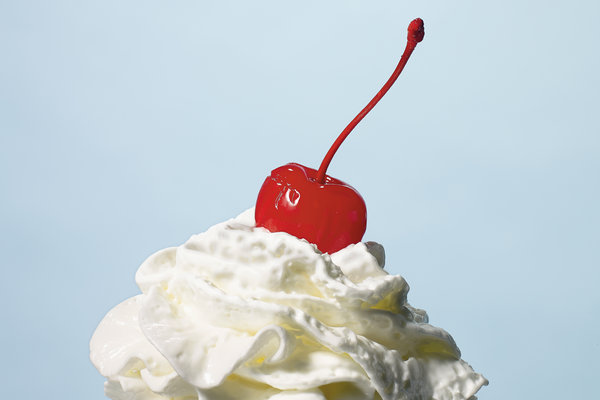(单词翻译:单击)
The modern maraschino cherry is “a real cherry with the cherry flavor removed,” explains Darcy O’Neil, a chemist and the author of “Fix the Pumps,” a history of the soda fountain. The original version, by contrast, was a marasca cherry — a sour, dark variety cultivated on the coast of Dalmatia (now part of Croatia) beginning in the mid-19th century. It was brined in ocean water, then preserved in a liqueur made from its own juices, as well as leaves and ground-up pits.
现代的酒渍马拉斯奇诺樱桃(maraschino cherry,特指冰淇淋、鸡尾酒,奶油蛋糕等物上的装饰性红樱桃——译注)是一种“去掉了樱桃味的樱桃”,化学家达西·奥尼尔(Darcy O’Neil)说,他曾出版讲述冷饮机历史的《修好水泵》(Fix the Pumps)一书。马拉斯奇诺樱桃是用欧洲酸樱桃制成的,二者截然相反。欧洲酸樱桃又酸又黑,是19世纪中期在达尔马提亚(今克罗地亚境内)培育出来的。制作方法是将它用海水浸泡,之后用同一种樱桃的汁液、叶子和碾碎的籽制成的甜酒腌渍。

The fruit first arrived on American shores as a luxury import around the turn of the century, along with a cheaper version made primarily in France using sugar and dyes. Large shipments of European cherries that had been preserved but not fully transformed into maraschinos were also sent to the United States — American cherries were considered unacceptable because of their mushier texture — where they, too, were made into less rarefied versions of the Croatian original.
在19世纪与20世纪之交,这种果子作为一种奢侈的进口物品来到美国大洋两岸,此外还有一种较为便宜的法国制造品种,用糖和颜料浸渍而成。美国樱桃被认为质地较软,无法用来制作马拉斯奇诺樱桃,于是大量欧洲半成品樱桃也被运往美国,在美国本土加工制作,但没有克罗地亚的原产品那么正宗。
Americans happily gobbled up imitation marascas, usually flavored with vanilla or almond. But when information about how they were made was leaked, outraged articles followed. “Maraschino Cherries Violate Pure Food Law,” ran one 1907 headline. According to another report, the fruit was smoked in sulfur and packed in a noxious chemical brine before shipping; once in the factory, it was soaked in sugar syrup, flavored and dyed red with aniline, a toxic colorant made of coal-tar byproducts. So many maraschino impostors — some alcoholic and some not — hit the market that in 1912, the Food and Drug Administration issued an official statement on the difference between a real maraschino and an imitation.
美国人开心地吃着这些仿制樱桃,通常是配香草和杏仁一起吃。但是当制作过程泄露后,开始出现愤怒的抨击文章,1907年,一篇文章题为“马拉斯奇诺樱桃触犯纯净食品法”。另一篇报道写道,这些樱桃经过硫磺烟熏,在运输前被浸泡在一种臭名昭著的化学制剂里。在工厂,它们被浸入糖浆,用苯胺调味和染上红色——苯胺是一种有毒的着色剂,由煤焦油的副产品制成。大量冒牌马拉斯奇诺樱桃涌入市场(有些是酒渍的,有些不是),1912年,美国食品和药物管理局发表了一份官方声明,澄清真假马拉斯奇诺樱桃的不同之处。
None of these alarming findings stopped people from eating the candied treats. It wasn’t long before American cherry growers, particularly in Oregon, where there were vast orchards, looked for ways to break into the market. Ernest Wiegand, a horticulturist at Oregon Agricultural College (now Oregon State University), focused on figuring out how best to preserve the shape and structure of local cherries to the standards Americans expected. “Preserving them with alcohol causes them to shrink,” O’Neil explains. “They become hard and wrinkled, and they don’t look like a plump, beautiful cherry.” In 1925, Wiegand discovered that adding calcium salts to the preserving brine firmed up the fruit. With a few modifications, this is still the method used to make maraschinos today. And while the maraschino we know has long been a kind of Frankenstein’s monster of the fruit world, in a Manhattan or on a sundae it offers a certain reliable comfort. “It’s got this burst of sweetness and sugar and childhood in it,” O’Neil says. “And those are good associations.”
这些警告并没有阻止人们继续食用这种甜品。不久后,美国樱桃种植者,特别是拥有大片果园的俄勒冈州的种植者们找到办法打入这个市场。厄内斯特·维甘德是俄勒冈农业学院(今俄勒冈州立大学)的园艺学家,他致力于让本土樱桃的形状和质地在腌渍过程能够达到美国人期待的标准。“用酒精腌渍会让它们缩水,”奥尼尔说,“会让它们变硬起皱,看上去就不像美丽丰满的樱桃了。”1925年,维甘德发现,在腌渍液中加入钙盐,会让樱桃变得质地坚实。经过若干调整,这个方法如今仍应用在制作马拉斯奇诺樱桃的工序中。我们熟悉的马拉斯奇诺樱桃早已成为水果界的弗兰肯斯坦怪物,但当它随曼哈顿鸡尾酒和圣代冰淇淋一起端上来的时候,还是让人有种安心的舒适感。“它包含了关于甜蜜、糖果和童年的感觉,”奥尼尔说。“这些都是美妙的联想。”


